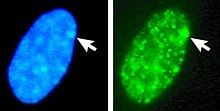

A Barr body (named after discoverer Murray Barr)[1] or X-chromatin is an inactive X chromosome. In species with XY sex-determination (including humans), females typically have two X chromosomes,[2] and one is rendered inactive in a process called lyonization. Errors in chromosome separation can also result in male and female individuals with extra X chromosomes. The Lyon hypothesis states that in cells with multiple X chromosomes, all but one are inactivated early in embryonic development in mammals.[3][4] The X chromosomes that become inactivated are chosen randomly, except in marsupials and in some extra-embryonic tissues of some placental mammals, in which the X chromosome from the sperm is always deactivated.[5]
In humans with euploidy, a genotypical female (46, XX karyotype) has one Barr body per somatic cell nucleus, while a genotypical male (46, XY) has none. The Barr body can be seen in the interphase nucleus as a darkly staining small mass in contact with the nucleus membrane. Barr bodies can be seen in neutrophils at the rim of the nucleus.
In humans with more than one X chromosome, the number of Barr bodies visible at interphase is always one fewer than the total number of X chromosomes. For example, people with Klinefelter syndrome (47, XXY) have a single Barr body, and people with a 47, XXX karyotype have two Barr bodies.
- ^ Barr, M. L.; Bertram, E. G. (1949). "A Morphological Distinction between Neurones of the Male and Female, and the Behaviour of the Nucleolar Satellite during Accelerated Nucleoprotein Synthesis". Nature. 163 (4148): 676–677. Bibcode:1949Natur.163..676B. doi:10.1038/163676a0. PMID 18120749. S2CID 4093883.
- ^ Lyon, M. F. (2003). "The Lyon and the LINE hypothesis". Seminars in Cell & Developmental Biology. 14 (6): 313–318. doi:10.1016/j.semcdb.2003.09.015. PMID 15015738.
- ^ Brown, C.J., Robinson, W.P., (1997), XIST Expression and X-Chromosome Inactivation in Human Preimplantation Embryos Am. J. Hum. Genet. 61, 5–8 (Full Text PDF)
- ^ Lyon, M. F. (1961). "Gene Action in the X-chromosome of the Mouse (Mus musculus L.)". Nature. 190 (4773): 372–373. Bibcode:1961Natur.190..372L. doi:10.1038/190372a0. PMID 13764598. S2CID 4146768.
- ^ Lee, J. T. (2003). "X-chromosome inactivation: a multi-disciplinary approach". Seminars in Cell & Developmental Biology. 14 (6): 311–312. doi:10.1016/j.semcdb.2003.09.025. PMID 15015737.